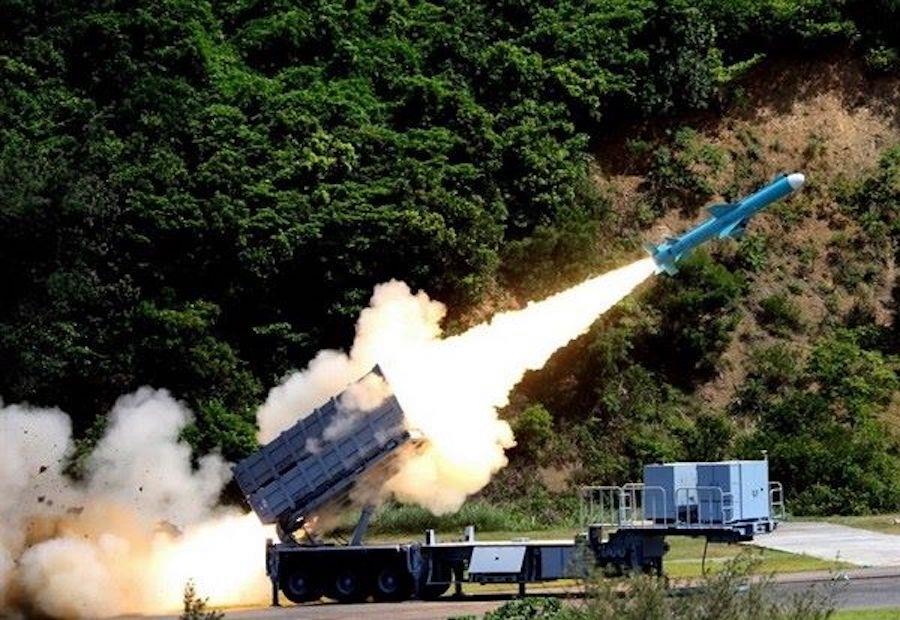(MENAFN- Asia Times) Taiwan has test-fired a missile reportedly capable of hitting mainland China and is developing drones to provide ISR (intelligence, surveillance, and reconnaissance) capabilities for targeting purposes.
This week, the south china morning post (SCMP) reported that Taiwan's National Chung-Shan Institute of Science and Technology (NCSIST) test-fired a possible extended-range version of the Hsiung Feng 2E land-attack cruise missile from its Jiupeng base in the island's southernmost county Pingtung on Tuesday.
The SCMP says Taiwan tested the missile in the airspace from Green Island and Orchid Island and northeast to Yilan county, flying 300 kilometers north to south, 180km east to west, at an altitude of 30km. In addition, the source notes that the Hsiung Feng 2E has a range of 1,200km, far enough to hit Qingdao on China's east coast and Wuhan in the center.
The source said that while the NCSIST declined to identify the missile it tested, it said an unnamed military observer said it might be the new Hsiung Sheng missile. It also stated that there will be four more tests this month.
In addition to testing a new type of missile, the SCMP said the NCSIST was working closely with Taiwan's civilian drone companies to create five surveillance drones for military use. The source notes these models are carrier-launched, land-based, target acquisition, surveillance, and miniature drones.
The SCMP notes that mass production of these drones could begin next year after tests for performance and effectiveness. It also reports that the NCSIST plans to order 30,000 of these drones, with contractors required to prove that their drones do not contain parts manufactured in China, or funded by China, for security reasons.
asia times has previously reported on Taiwan's efforts to build a missile arsenal that can strike targets deep in China's territory. From 2004 to 2007, NCSIST covertly developed the Yung Feng ramjet-powered supersonic cruise missile, Hsiung Feng 2E land-attack cruise missile, and the Ba Dan ballistic missile.
These missile projects may be the cornerstone of a“pit viper” strategy, emphasizing the capability to retaliate and raise the political costs of China's attempts at reunification by force.
In line with that, asia times has previously noted that conventional deterrence is an essential complement to nuclear deterrence, and in Taiwan's case, extended deterrence. Weapons such as conventionally tipped ballistic and cruise missiles are increasingly becoming more powerful due to the“informatization” of conventional strike capabilities.
Also, conventional weapons are more applicable in a broader range of circumstances, have greater flexibility than nuclear weapons, and are not subject to the political constraints of the latter.
Deterrence by denial
Given that, Taiwan's new missiles are part of its efforts to improve its conventional deterrence posture in“deterrence by denial” strategy.
according to a 2018 discussion by Michael Hunzeker and other experts at the Stimson Center, Taiwan faces a conventional deterrence trilemma in its three possible courses of action to deter China's conflict with one another.
According to Hunzeker, Taiwan needs to counter China's subversive“gray zone” actions using high-visibility frigates and fighter jets, but without provoking a military response from the latter. Further, he says Taiwan must convince China that an invasion attempt will be unacceptably costly, using numerous survivable assets.
Yet the latter is likely to use its large missile arsenal, special operations forces, cyber warfare capabilities, and other means to destroy the former's weapons before an invasion. Moreover, he notes that Taiwan can pursue both courses of action, but it has limited resources and therefore has to make compromises.
To break this trilemma, Hunzeker says Taiwan should adopt an“elastic denial in depth” strategy, which entails accepting more risks with China's gray-zone activities, prioritizing imposing unacceptable costs in the event of an invasion, and preparing for territorial defense and popular resistance.
Given Taiwan's strategic trilemma and Hunzeker's proposed elastic denial-in-depth strategy, Taiwan's long-range missiles may be the ideal conventional deterrence choice, given its constraints. Taiwan may have long been aware of the strategic trilemma pointed out and is mindful of the advantages of conventional deterrence. Hence it has covertly and overtly developed long-range strike capabilities that allow it to punch above its weight.
Coupled with space-based real-time ISR capabilities, even a limited number of these conventional missiles could have a strategic effect by hitting military, political, and economic centers of gravity.
However, Tiffany Pham, in a july 2021 paper for the us air university , notes that while Taiwan's deterrence strategy relies heavily on missiles guided by satellite data, Taiwan's space infrastructure is insufficient for a conflict against China.
Phan says Taiwan does not have a military branch dedicated to space support operations, no domestic satellite launch program, and no military satellites.
Also, in the long run, Taiwan may need to rely on more than a deterrence-by-denial strategy built around conventionally armed missiles.
in a may 2022 report by foreign policy , Melanie Sisson points out the reactive and fail-deadly nature of deterrence-by-denial strategy. Sisson says such a strategy based on showing China would lose in a military confrontation places the US and Taiwan on a permanent war footing, which makes pressured reactions more likely than deliberate responses, emphasizing the failure of deterrence-by-denial results in war.
In line with one of the caveats mentioned by Hunzeker, Sisson says that a deterrence-by-denial strategy for Taiwan is expensive and self-limiting, which forces its national defense strategy to be centered on a one-war scenario and makes the US pull its punches in deploying its military capabilities and other instruments of national power.
Given that, Taiwan's focus on conventionally armed missiles for deterrence by denial potentially limits its courses of action, as missiles have limited operational and tactical flexibility, given that they can do little aside from sit and wait for targets.
Also, potential US over-emphasis on hardening Taiwan's defenses might result in overlooking other forms of deterrence beyond the threat of force, such as export controls, sanctions, inflicting reputational costs, and strengthening regional partnerships and alliances.



















Comments
No comment